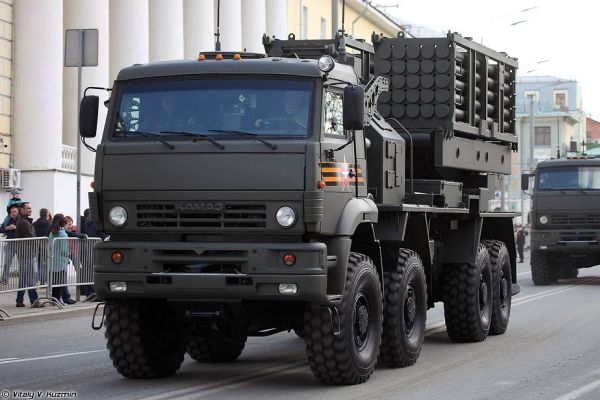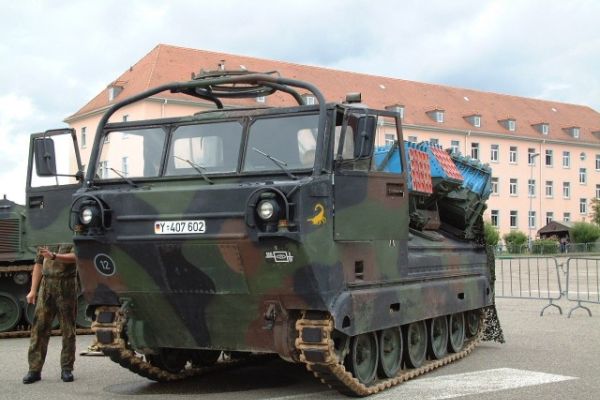Mine Laying Systems.
GMZ-3.

The GMZ-3 (Gusenichniy Minniy Zagraditel-3) is a Russian minelayer based on a tracked armored vehicle designed to lay and automatically arm anti-tank pressure and magnetic influence mines, both on the surface and buried beneath soil or snow. Developed in the Soviet era, the GMZ-3 serves primarily in engineering and tactical mine-laying roles within the Russian military.
Country users: Armenia, Azerbaijan, Belarus, Kazakhstan, Kyrgyzstan, Russia, Tajikistan, Turkmenistan, Uzbekistan.
Description
The GMZ-3 is a tracked armored vehicle designed for the specialized purpose of laying anti-tank mines. It was developed to increase the speed and precision of minefield deployment, which is a critical task in both defensive and offensive military operations. Its primary role is to lay, arm, and conceal anti-tank pressure and magnetic influence mines across a battlefield, either on the surface or buried underneath the soil or snow. The system ensures that mines are automatically delivered to the dispersing mechanism, and the vehicle’s onboard technology arms them shortly after deployment.
Developed in the 1970s by the Soviet Union, the GMZ-3 was designed to enhance mine-laying capabilities with greater automation and operational flexibility. It entered service in the early 1980s, replacing the older PMR-3 in Soviet engineer battalions. The vehicle quickly became a key asset in motorized rifle and tank divisions, streamlining the process of creating minefields, especially in response to enemy movements or in pre-planned tactical operations. It has continued to serve in the Russian military and other countries following the collapse of the Soviet Union.
Based on the chassis of the SA-4 Ganef surface-to-air missile system, the GMZ-3 leverages the proven mobility and durability of this platform. The vehicle has a specialized mine-laying system, featuring a plough assembly for burying mines and a conveyor system for surface deployment. Mines are automatically fed into the system and dispersed at controlled intervals, either 5 or 10 meters apart, depending on the desired field density. The vehicle can lay mines at speeds of up to 16 km/h on the surface and 6 km/h when burying mines. It is also equipped with a navigation system to track the minefield’s coordinates and integrate them into a tactical map.
In terms of operations, the GMZ-3 is designed to be flexible and efficient. It can rapidly lay mines in response to an enemy attack or deploy pre-planned minefields. The vehicle can also operate at night or in low-visibility conditions thanks to its infra-red vision equipment and land navigation system. Typically, a platoon of three GMZ-3 vehicles is assigned to an engineer battalion within motorized rifle or tank divisions, replacing the older PMR-3 in the field.
GMZ-3 variants:
No variants at this time.
Technical Data
-
Armament
The GMZ-3 is armed with a 14.5 mm KPVT heavy machine gun mounted above the commander’s position for its self-protection. This machine gun provides limited defense against light vehicles or enemy personnel but is secondary to the vehicle’s mine-laying capabilities. The primary function of the GMZ-3 is its automated mine deployment system, which can lay anti-tank pressure mines and magnetic influence mines. The system is capable of deploying mines in two ways: on the surface or buried beneath the ground.
The mine deployment mechanism works by feeding mines from the rear storage compartment into the dispersing mechanism via two chutes. These mines are then transferred through ports in the rear plate of the vehicle and onto the conveyor system, which arms them after a short delay. The GMZ-3 can lay mines in intervals of 5 or 10 meters, ensuring precise spacing in the minefield. It can lay up to 208 anti-tank mines, which are loaded through two large roof hatches.
For surface laying, the mines are directly dispersed from the conveyor. For buried deployment, the vehicle utilizes a plough assembly, which digs a furrow for the mines to be placed in, ensuring they are concealed under up to 120 mm of soil or 500 mm of snow. The system can lay mines at a maximum speed of 16 km/h on the surface and 6 km/h when burying them. It is capable of laying 8 mines per minute when surface laying and 4 mines per minute when burying mines.
-
Design and protection
The GMZ-3 is a specialized mine-laying vehicle designed with a focus on both mobility and protection. Its chassis is based on the SA-4 Ganef surface-to-air missile system, which provides a robust and reliable platform for mine-laying operations. The vehicle is specifically built for rapid mine deployment, and its layout is optimized for the effective functioning of the mine-laying system while ensuring crew safety during operations.
The crew of the GMZ-3 consists of three personnel. The driver is positioned at the front left of the vehicle, behind an armored hull that provides some protection from small arms fire and shrapnel. To the right of the driver is the engine compartment, which powers the vehicle. The driver's position allows for direct control of the vehicle's movement, and he has a clear forward view through periscopes or vision blocks.
The commander sits in the turret area at the center of the vehicle. This position is elevated slightly, allowing the commander to have an overview of the battlefield while overseeing the operation of the vehicle. The commander is also in charge of the vehicle's 14.5 mm KPVT heavy machine gun, which is mounted above their position for self-defense and to provide additional protection during operations.
The operator is positioned at the rear right of the vehicle, where he is responsible for managing the mine-laying process. The operator controls the mine delivery system, which includes both the conveyor for surface mine deployment and the plough assembly for burying mines. The operator sits under a small raised superstructure, which provides protection while still allowing them visibility to monitor the mine-laying process and ensure effective operation. This placement at the rear allows the operator to oversee the rearward dispersal of mines and ensure that they are properly laid in the desired pattern.
The vehicle’s design incorporates armor to protect the crew and critical components from small arms fire and shrapnel. The armor is not heavily focused on full combat survivability but rather is designed to provide protection during mine-laying operations in potentially hostile environments. The armor extends to the key components, including the mine-laying mechanisms, ensuring that these vital systems are not easily damaged or disabled during operations. This design balances mobility and protection, enabling the GMZ-3 to quickly deploy mines while safeguarding the crew from immediate threats.
-
Mobility
The GMZ-3’s mobility is based on the proven SA-4 Ganef chassis, which is equipped with a KaMAZ-7482 water-cooled diesel engine, delivering 525 horsepower. This engine provides the vehicle with a power-to-weight ratio of 18.42 hp/t, ensuring adequate speed and mobility across different terrains. The GMZ-3 has a maximum speed of 60 km/h on roads, with a cruising speed between 40 to 45 km/h. On dirt roads and rougher terrain, it can operate at speeds of 25 to 30 km/h. The vehicle’s range is 500 kilometers on roads, making it well-suited for extended operations.
The GMZ-3 is equipped with torsion bar suspension, providing it with a seven-roadwheel configuration. This system allows the vehicle to traverse difficult terrains such as mud, sand, snow, and rocky areas with ease. The vehicle can ford water up to 1 meter deep, climb gradients of up to 30°, and cross side slopes of up to 46.7%. It can also clear a vertical step up to 0.7 meters high and cross a trench as wide as 2.5 meters. These capabilities give the GMZ-3 a significant advantage in deployment flexibility in varied terrain types.
-
Combat Equipment
The GMZ-3 is primarily equipped for its role as a mine-laying vehicle, but it also has some combat and operational features that ensure its protection and effectiveness. The 14.5 mm KPVT heavy machine gun mounted above the commander’s position provides a defensive capability against light vehicles, infantry, or aerial threats.
The vehicle is also fitted with smoke grenade launchers, offering a means to obscure its position and operations from enemy observation. Additionally, the GMZ-3 has a smoke production system integrated into its exhaust system, which can be used to create a large smokescreen, further aiding in concealment during mine-laying operations or retreat.
In terms of operational equipment, the GMZ-3 comes with a land navigation system and infra-red vision equipment. This allows the vehicle to operate effectively in both daylight and night-time conditions, providing a significant tactical advantage. The vehicle can conduct mine-laying operations under low-visibility conditions, ensuring that it can perform its mission around the clock if required.
Specifications
-
Armament
- 14.5 mm KPVT heavy machine gun and smoke dischargers.
- Mine Capacity: 208 anti-tank mines (pressure and magnetic influence mines) -
Country users
Armenia, Azerbaijan, Belarus, Kazakhstan, Kyrgyzstan, Russia, Tajikistan, Turkmenistan, Uzbekistan.
-
Designer Country
Russia
-
Combat Equipment
Infra-red vision, land navigation system, minefield tracking system
-
Crew
3 (Driver, Commander, Operator)
-
Armor
Protection against the firing of small arms and artillery shell splinters
-
Mine deployment
Automatic mine delivery (surface or buried via plough assembly)
-
Speed Vehicle
60 km/h (max), 40–45 km/h (cruising), 25–30 km/h (dirt roads)
-
Range Vehicle
500 km
-
Dimensions
Length: 8.62 m; Width: 3.25 m; Height: 2.7 m







































